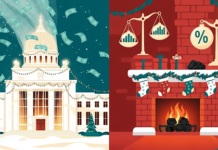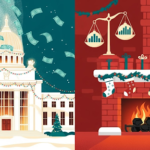Why Gold Glitters When the Dollar Falters
A strange thing happened on the way to the government shutdown: investors got bullish on bitcoin and gold. While Washington bickers, markets are making moves — and the debasement trade is having a moment.
We’re now witnessing a market theme that’s less about short-term headlines and more about long-term conviction. Think of it as the investment world’s quiet rebellion against political dysfunction, persistent deficits, and shaky monetary policy. With real interest rates sliding, inflation lingering, and the U.S. fiscal picture looking ever more precarious, investors are rotating out of fiat currencies and into assets with perceived intrinsic value. And right now, that means gold, bitcoin, and a growing mistrust of the dollar’s staying power.
One thing’s clear: investors aren’t waiting for Washington to figure things out. They’re voting with their wallets.
This Week I Learned…
The Quiet Power Behind the Debasement Boom
This week I learned that individual investors, not institutions, are leading the charge on the debasement trade, and they’re doing it with ETFs.
In a world of algorithmic trading and hedge fund headlines, it’s easy to overlook the everyday investor. But according to data from J.P. Morgan, it’s the retail crowd that kickstarted the current surge into bitcoin and gold. ETF flows into both assets began accelerating back in late 2024, right before the last presidential election, and haven’t looked back since. Bitcoin led the way, with momentum building after President Trump’s tariff announcement in April. Gold caught up quickly by August.
It’s rare to see such alignment between two very different assets. One is centuries old, the other still facing questions about its staying power. But both are united under a common concern: fiat currencies might not be the safe haven they once were.
Why does this matter? Because retail flows are often sticky, driven by belief more than balance sheet metrics. And with concerns growing over inflation, fiscal irresponsibility, and central bank independence, these trades may be more than just reactive. They may represent a lasting shift in how everyday investors think about value.
The Fun Corner
A Gold Bar Walks Into a Portfolio
Gold just hit a record high, but have you ever stopped to consider what that actually buys you? At current prices, one standard 400-ounce gold bar, the kind stored in central banks, is worth over $1.56 million. That’s not just portfolio protection, that’s enough to buy 3 average homes in the Midwest, 1 hyperinflated avocado toast in San Francisco, and still have some change left for a gold-plated espresso machine.
Here’s the kicker: if you stacked those 400-ounce bars to match the height of the Empire State Building, it would be worth more than $1.1 billion, but also a nightmare for your chiropractor.
Moral of the story? Diversification is smart, but maybe don’t try stacking your retirement plan.
The Higher It Goes…
The phrase “debasement trade” might sound dramatic, but in 2025, it’s one of the most rational plays out there. It’s built on one powerful idea: if the U.S. dollar continues to lose purchasing power, investors need alternatives. And right now, those alternatives are gold and bitcoin.
This movement didn’t begin overnight. It started picking up steam in late 2024, gaining real momentum as the government shutdown loomed. But it’s more than a temporary reaction. Structural concerns are driving the shift: rising deficits, political dysfunction, inflation that just won’t fully retreat, and growing doubts about the Fed’s independence.
As the dollar weakens, down roughly 10 percent this year, both gold and bitcoin have soared. Bitcoin topped $125,000 for the first time ever. Gold just logged its 41st record high of the year. These aren’t anomalies. They’re data points in a longer-term rotation away from fiat and toward assets seen as harder to manipulate.
ETF flow data confirms this isn’t just an institutional story. Retail investors are out front, and institutional money is starting to follow. Some analysts project bitcoin could hit $181,000 within a year. Others see gold breaching $4,000 by year-end. These are not hype calls. They’re based on demand dynamics and deep concerns over fiscal sustainability.
There’s risk here, of course. The dollar hasn’t collapsed, and shutdowns don’t guarantee upside in gold and bitcoin. But in an era where trust in central banks and governments is eroding, the debasement trade is less a speculation and more a recalibration.
Investors are no longer betting on growth. They’re hedging against erosion.
The Last Say
Not Just a Shutdown Story
If there’s one lesson from this week, it’s that markets have stopped waiting for clarity from Washington. The surge in gold and bitcoin isn’t just a short-term trade reacting to a government shutdown. It’s a signal of deeper shifts in investor psychology.
This isn’t about panic. It’s about positioning. Whether you see gold as a time-tested safe haven or bitcoin as the new digital vault, the core belief behind the debasement trade is that something fundamental has changed. Investors are less confident in the ability of governments to manage debt, inflation, and economic policy responsibly.
What’s striking is how individual investors led this trend before institutional players followed. It’s a reminder that markets don’t always move top-down. Sometimes, they move with the quiet conviction of a large and motivated crowd.
The government shutdown may pass, but the conditions that made the debasement trade popular, and perhaps essential, remain. High deficits. Political dysfunction. Currency risk. If those aren’t addressed, don’t be surprised if we’re talking about gold at $4,500 and bitcoin at $150,000 sooner than expected.
Whether you’re in or out of these trades, the key takeaway is clear: the market is voting, and it’s losing faith in fiat.























